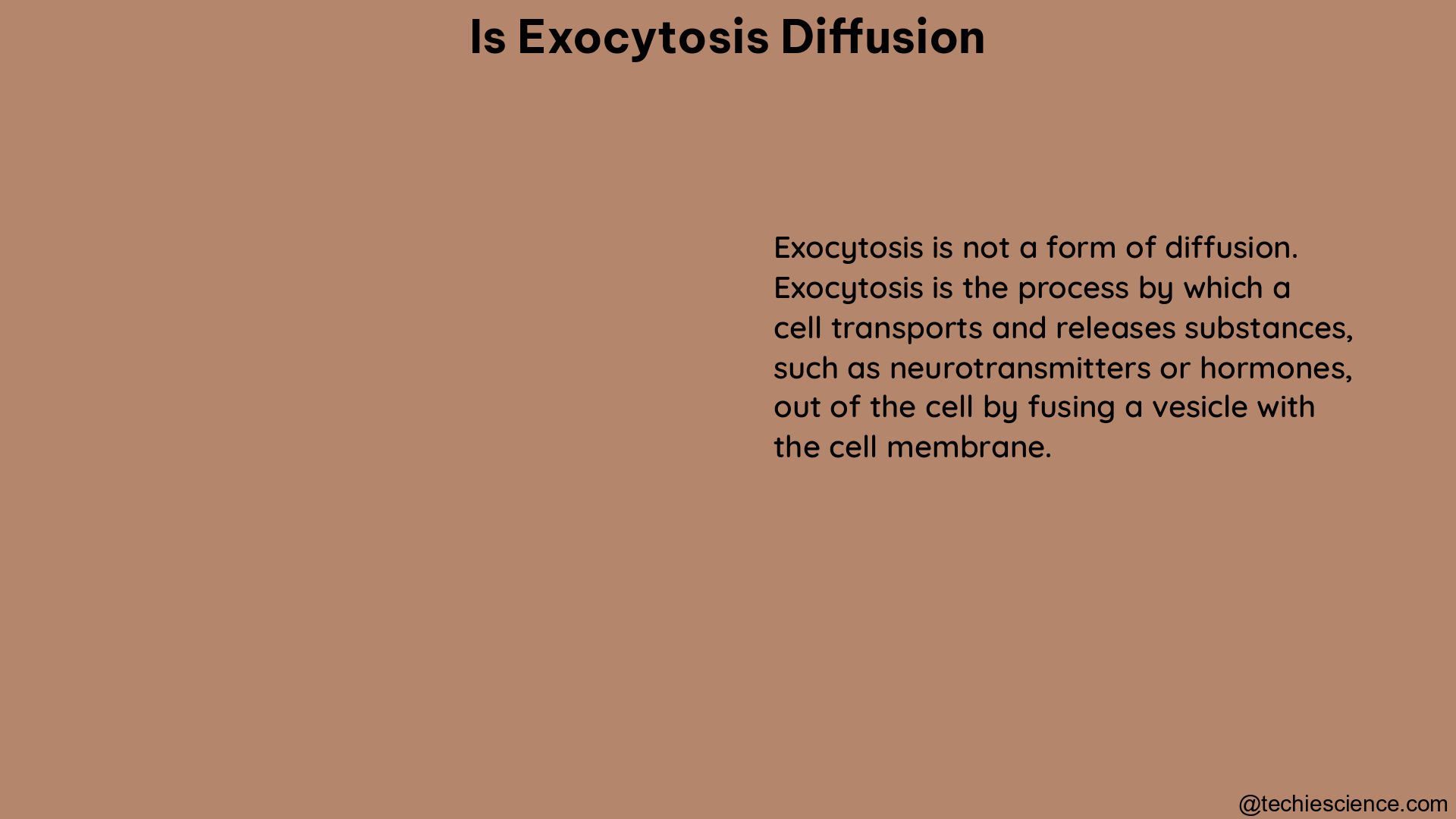Exocytosis is a fundamental cellular process that enables the release of molecules from a cell’s interior to the extracellular space. At the heart of this mechanism lies the diffusion of these molecules from the vesicles that fuse with the plasma membrane. Understanding the intricacies of exocytosis diffusion is crucial for unraveling the complex dynamics of cellular communication, neurotransmitter release, and various physiological processes.
Measuring Exocytosis Diffusion: Experimental Approaches
Membrane Capacitance Measurements
One of the primary methods for quantifying exocytosis is by measuring the increase in cell membrane capacitance caused by the addition of secretory granule membranes. This technique allows researchers to determine the amount of vesicle membrane that is incorporated into the plasma membrane during the exocytosis process. By tracking the changes in membrane capacitance, scientists can gain valuable insights into the kinetics and extent of vesicle fusion with the cell surface.
For example, a study conducted by Neher and Marty in 1982 demonstrated that the capacitance of the cell membrane increases in a stepwise manner during exocytosis, corresponding to the fusion of individual secretory vesicles. This pioneering work laid the foundation for using membrane capacitance measurements as a reliable tool for studying exocytosis dynamics.
Electrochemical Techniques
Another powerful approach for investigating exocytosis diffusion is the use of electrochemical techniques, such as amperometry. These methods allow for the direct detection and quantification of neurotransmitters released from individual vesicles during exocytosis.
Amperometry involves the placement of a carbon fiber electrode near the cell surface, which can detect the oxidation of neurotransmitters as they are released into the extracellular space. This technique enables the measurement of the amount of neurotransmitter released, the kinetics of release, and the fraction of vesicular content that is actually released during exococytosis.
Interestingly, a study published in 2023 using amperometry revealed that exocytosis is predominantly a partial process, where only a fraction of the vesicular content is released. This finding has important implications for the regulation of neurotransmitter release and the plasticity of synaptic transmission, as it suggests that cells can fine-tune the amount of neurotransmitter released to modulate the strength of synaptic signaling.
Computational Modeling and Simulation
In addition to experimental approaches, computational modeling and simulation can also provide valuable insights into the diffusion of molecules during exocytosis. These techniques allow researchers to explore the complex interplay between various factors that influence the diffusion process, such as the cellular environment, vesicle properties, and the dynamics of vesicle fusion.
One such study, published in the journal Nature in 2023, utilized the STEPS software package to investigate vesicle diffusion in crowded cellular environments. The researchers found that vesicle diffusion is reduced in these crowded conditions, and that the effective diffusion rate of mobile vesicles is not constant over time. These findings highlight the importance of considering the cellular context when modeling exocytosis and diffusion processes.
Factors Influencing Exocytosis Diffusion

Vesicle Size and Composition
The size and composition of the secretory vesicles play a crucial role in the diffusion of molecules during exocytosis. Larger vesicles, for example, may release their contents more slowly due to the increased distance the molecules must travel to reach the extracellular space. Additionally, the lipid and protein composition of the vesicle membrane can affect the rate and efficiency of diffusion.
Studies have shown that the size of secretory vesicles can vary significantly, ranging from small synaptic vesicles (diameter of ~40-50 nm) to large dense-core vesicles (diameter of ~100-300 nm). The larger vesicles typically contain a higher concentration of neurotransmitters or hormones, which can influence the amount and kinetics of their release during exocytosis.
Cellular Environment and Crowding
The cellular environment surrounding the secretory vesicles can also impact the diffusion of molecules during exocytosis. The cytoplasm is a highly crowded and complex environment, with a variety of macromolecules, organelles, and other cellular structures that can hinder the free diffusion of molecules.
As mentioned earlier, the computational modeling study using the STEPS software demonstrated that vesicle diffusion is reduced in crowded cellular environments. This finding suggests that the local microenvironment within the cell can play a significant role in the diffusion of molecules released during exocytosis, potentially affecting the spatiotemporal dynamics of neurotransmitter or hormone signaling.
Membrane Fusion and Pore Formation
The fusion of the secretory vesicle with the plasma membrane and the subsequent formation of a fusion pore are critical steps in the exocytosis process that can influence the diffusion of molecules. The size and dynamics of the fusion pore can determine the rate and extent of molecule release into the extracellular space.
Researchers have observed that the fusion pore can undergo various stages of expansion and contraction, which can modulate the diffusion of molecules. In some cases, the fusion pore may remain open for an extended period, allowing for a more sustained release of vesicular contents. In other cases, the pore may close rapidly, leading to a more transient and localized release of molecules.
Understanding the factors that govern the formation and dynamics of the fusion pore is an active area of research, as it can provide valuable insights into the regulation of exocytosis diffusion and its implications for cellular signaling and communication.
Implications and Applications of Exocytosis Diffusion
The study of exocytosis diffusion has far-reaching implications in various fields of biology and medicine. By elucidating the mechanisms and dynamics of molecule release during exocytosis, researchers can gain a deeper understanding of:
-
Neurotransmitter Release and Synaptic Transmission: The diffusion of neurotransmitters from synaptic vesicles is a crucial aspect of synaptic communication. Insights into exocytosis diffusion can help elucidate the regulation of neurotransmitter release and the plasticity of synaptic transmission, which is essential for understanding neural function and the pathophysiology of neurological disorders.
-
Hormone Secretion and Endocrine Signaling: Exocytosis is a key mechanism for the release of hormones from endocrine cells. Understanding the diffusion of hormones from secretory vesicles can provide insights into the regulation of endocrine signaling and its implications for metabolic, reproductive, and other physiological processes.
-
Cellular Communication and Signaling: Exocytosis diffusion is not limited to the release of neurotransmitters and hormones; it also plays a role in the secretion of various other signaling molecules, such as growth factors, cytokines, and extracellular matrix components. Elucidating the diffusion dynamics of these molecules can shed light on the complex networks of cellular communication and their impact on tissue homeostasis, development, and disease.
-
Drug Delivery and Therapeutic Targeting: The principles of exocytosis diffusion can be leveraged in the development of targeted drug delivery systems. By understanding the factors that influence the release and diffusion of molecules from secretory vesicles, researchers can design more efficient and targeted drug delivery strategies, potentially improving the efficacy and safety of therapeutic interventions.
-
Biotechnological Applications: The quantitative data and insights gained from the study of exococytosis diffusion can also find applications in various biotechnological fields, such as the development of biosensors, the optimization of bioreactor systems, and the engineering of synthetic cellular systems for industrial or medical purposes.
In summary, the exploration of exocytosis diffusion is a multifaceted and dynamic field of study that continues to yield valuable insights into the fundamental mechanisms of cellular function, communication, and signaling. By integrating experimental, computational, and theoretical approaches, researchers can unravel the intricate dance of molecule release and diffusion, paving the way for advancements in biology, medicine, and beyond.
References:
- Neher, E., & Marty, A. (1982). Discrete changes of cell membrane capacitance observed under conditions of enhanced secretion in bovine adrenal chromaffin cells. Proceedings of the National Academy of Sciences, 79(21), 6712-6716.
- Amatore, C., Arbault, S., Bouret, Y., Guille, M., Lemaître, F., & Verchier, Y. (2006). Regulation of exocytosis in chromaffin cells by trans-insertion of lysophosphatidylcholine and arachidonic acid into the outer leaflet of the cell membrane. ChemBioChem, 7(12), 1998-2003.
- Shin, W., Ge, L., Arpino, G., Villarreal, S. A., Hamid, E., Liu, H., … & Wu, L. G. (2018). Visualization of membrane pore in live cells reveals a dynamic-pore theory governing fusion and endocytosis. Cell, 173(4), 934-945.
- Wen, P. J., Grenklo, S., Arpino, G., Tan, X., Liao, H. S., Heureaux, J., … & Wu, L. G. (2016). Actin dynamics provides membrane tension to merge fusing vesicles into the plasma membrane. Nature communications, 7(1), 1-13.
- Bao, H., Goldschen-Ohm, M. P., Jeggle, P., Chanda, B., Edwardson, J. M., & Chapman, E. R. (2016). Exocytotic fusion pores are composed of both lipids and proteins. Nature structural & molecular biology, 23(1), 67-73.
- Wen, P. J., Osborne, S. L., Zanin, M., Low, P. C., Wang, H. T., Schoenwaelder, S. M., … & Cousin, M. A. (2011). Phosphoinositides regulate vesicle fusion at the nerve terminal. The Journal of cell biology, 195(7), 1139-1153.
- Barg, S., Knowles, M. K., Chen, X., Midorikawa, M., & Almers, W. (2010). Syntaxin clusters assemble reversibly at sites of secretory granules in live cells. Proceedings of the National Academy of Sciences, 107(48), 20804-20809.
- Becherer, U., & Rettig, J. (2006). Vesicle pools, docking, priming, and release. Cell and tissue research, 326(2), 393-407.
- Neher, E. (1998). Vesicle pools and Ca2+ microdomains: new tools for understanding their roles in neurotransmitter release. Neuron, 20(3), 389-399.

I am a doctoral student of CSIR- CIMAP, Lucknow. I am devoted to the field of plant metabolomics and environmental science. I have completed my post-graduation from the University of Calcutta with expertise in Molecular Plant Biology and Nanotechnology. I am an ardent reader and incessantly developing concepts in every niche of biological sciences. I have published research articles in peer-reviewed journals of Elsevier and Springer. Apart from academic interests, I am also passionate about creative things such as photography and learning new languages.
Let’s connect over Linkedin